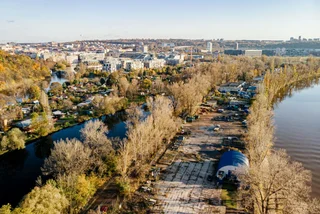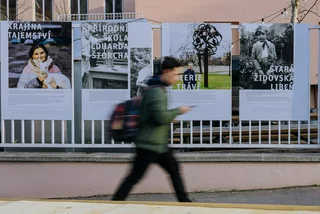While most people think of Prague as one big unified metropolis, it grew over time by absorbing the municipalities around it. The Libeň neighborhood joined Prague 120 years ago on Sept. 12, 1901.
Most of the neighborhood belongs to Prague 8. That district’s administration will be celebrating the anniversary on Aug. 28 from 2 pm to 6 pm in front of the White House, the administrative building at U Meteoru 6, with music and performances. Guided neighborhood tours (in Czech) will start Libeňský zámek. These events are free. There is also a theatrical performance at the zámek at 7:30 pm that requires tickets.
Prague itself isn’t as old a most people think. Hradčany, Malá Strana, New Town, and Old Town weren’t unified under one city administration until 1784. Josefov joined in 1850, followed by Vyšehrad in 1883, and Holešovice-Bubna in 1884.

Libeň came next. On April 16, 1901, the Provincial Act was approved. This allowed the annexation to take place in September. Libeň became eighth district of Prague, a designation it still keeps.
Vinohrady, Žižkov, Smíchov, and Vršovice, which most people think of a quintessential parts of the city, didn’t join until 1922. The last major expansion, which brought Prague to its current form, was in 1974.
In May this year, the Prague 8 district put two information panels in front of Libeňský zámek, one of the district’s historical sights as well as an administrative center.
“I'm happy to sleep, Prague, in your arms; always be our careful mother!” one of the panels states.
The first panel outlines event of Libeň’s annexation to Prague, including the celebrations on Sept. 12, 1901. The second panel shows important milestones from the first written mentions up through the introduction of kerosene street lights and tram service. Libeň was incorporated as a town in 1898, just three years before it merged with the city.
According to the Prague 8 website, Libeň had just 746 houses the year before it joined the city. It then began to expand into agricultural fields with new two- and three-story houses. This phase of development halted at the start of World War I.

Libeň’s history goes back as far as the Stone Age, as traces of early settlement have been found. The first written mention of the place as Libeň is in 1363. Due to its location near Prague but with the availability of wide open spaces, it first attracted wealthy burghers as residents. The chateau the grew into today’s Libeňský zámek was already standing at the start of the late 1500s.
In 1608 the chateau hosted the Roman Emperor Rudolf II and his brother Matthias of Habsburg, who signed the Treaty of Libeň, dividing power between them and settling a family rift.

The current Rococo look building is from 1770. It was renovated to repair damage from the 1757 Prussian invasion of Bohemia. Empress Maria Theresa contributed to the repairs and also visited.
The transformation into a working class neighborhood with factories began in the 19th century, with machine works, textile mills, breweries, distilleries, and concrete factories taking over from vineyards and farmland.

It was also a diverse neighborhood. A former synagogue still stands at Palmovka, one of the district’s main hubs. A field where a Jewish cemetery once stood is nearby, but the markers were destroyed in the last century.
Much of the 19th century housing remains, but the factories are no longer in operation, and many have been torn down. O2 Arena, in Prague 9 but technically part of Libeň, was built on the site of a former ČKD locomotive factory.

One of the most famous incidents to take place in the district was the assassination of acting Reichsprotektor Reinhard Heydrich on May 27, 1942, by a squad of Czechoslovak paratroopers. Heydrich died of his wounds on June 4. the mission was called Operation Anthropoid, and has been the subject of several films and books.
The Operation Anthropoid Memorial was erected in 2009 near the location of where the paratroopers hit Heydrich’s car with a grenade, injuring him with shrapnel. The exact area is hard to locate as a highway now covers the spot. The memorial feature three figures with outstretched arms on top of a steel pillar. A large mural depicting the same event was unveiled earlier this year.

Perhaps the most famous person to come from the neighborhood is author Bohumil Hrabal, who lived there from the 1950s. He died in 1997 after a fall from a window at Bulovka Hospital, also located in the district.
A mural depicting him is near the Palmovka metro station and bus depot. A plaque is on the site of a house he once lived in. A cornerstone for a Bohumil Hrabal Center was laid in 2004, but not other work in the center has occurred so far.

When the Palmovka area is redeveloped, a square named after Hrabal should be created where the bus depot now stands.
Other famous people from the area include 19th century poet Karel Hlaváček, late 19th and early 20th century opera singer Ernestine Schumann-Heink, and 20th century surrealist writer Stanislav Vávra.












 Reading time: 4 minutes
Reading time: 4 minutes 






















